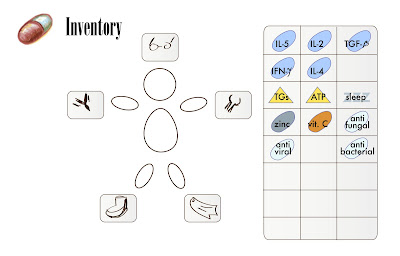 Game play
Game play icons, health bar, and map. Icons from left to right: immunopedia button, inventory button, nanorg stats button, cell stats button.
 Inventory
Inventory window/display. On the left is a rough nanorg/humanoid body, with boxes to place items (i.e. goggles on the head, boots or flippers on feet, antibody or MHC complex items on the hands).
On the right is a palette that holds drugs (anti-bacterial, anti-fungal, anti-viral), vitamins, energy supplies, and other immune-boosting items (like sleep).
TG= triglycerides; ATP = adenosine triphosphate. There are also proliferation and differentiation cytokines (IL-2, IL-4, IL-5, TGF-beta, IFN-gamma).
Nanorg statistics window. The red-green cell orb on the upper right fills up with experience gained in gameplay; when it reaches 100% the nanorg levels up. Each level increase provides roughly 10 skill points, which can be funnelled into vitality, strength, luck or knowledge attributes.
HP = hit points; these increase with vitality and level. CP = cell points (affects how many and how well you control immune cells); these increase with knowledge and level.
Cell statistics window. These represent the cells the nanorg can control (the number will increase with game progress/levelling).
The tabs on the top let you view either 'myeloid' lineage (eosinophil, basophil, megakaryote, and monocyte) or 'lymphoid' (T, B, and natural killer/NK) cells.
Through the tabs on the left, you can access 'early' (mostly naive and centroblast) and 'late' (mostly memory and plasma) B cells. Geoff's cell stat sheets can be accessed by scrolling through b cells shown on a dock.
Immunopedia window. This will present background information on the science, fictional story, and play/logistic concepts of the game.




 Picture 3. Aka centroblast...?
Picture 3. Aka centroblast...?
 Game play icons, health bar, and map. Icons from left to right: immunopedia button, inventory button, nanorg stats button, cell stats button.
Game play icons, health bar, and map. Icons from left to right: immunopedia button, inventory button, nanorg stats button, cell stats button. Inventory window/display. On the left is a rough nanorg/humanoid body, with boxes to place items (i.e. goggles on the head, boots or flippers on feet, antibody or MHC complex items on the hands).
Inventory window/display. On the left is a rough nanorg/humanoid body, with boxes to place items (i.e. goggles on the head, boots or flippers on feet, antibody or MHC complex items on the hands). 
